Saturday, December 11, 2004
Billon antoninianus, Gallienus, Rome, Göbl 470q¹

GALLIENVS AVG, Radiate cuirassed bust right, both ribbons behind | LIBERAL AVG, Liberalitas standing facing, head left, holding cornucopia right and counting-board left. S in left field.
I've already used one Liberalitas reverse to point to "The Wild and Free Pigs of the Okefenokee Swamp" and another to talk about the counting-board that some catalogers insist on calling an abacus, which is just confusing, even if it fits one of the definitions.
By rights then, I should find something new to say, but suddenly I am run over by a truck.
Friday, December 10, 2004
Æ23, Antioch in Pisidia, Gallienus, Lindgren I, 1258var

IMP C P ΛEI LIC GVII?NO, Radiate draped cuirassed bust right | A_NTIC_O[.]CIL, Tyche of Antioch standing facing, head left, holding branch left and cornucopia right. Γ beneath branch,
Illiteracy at the mint in Pisidian Antioch seems to have been very real, worsening over time, until by this reign legends on coins must be interpreted rather than read, a confusing mix of Roman, Greek, and apparently imaginary letters.
Update: corrected reverse description, which was confused with this other example of the coin.
Thursday, December 09, 2004
Silvered Æ antoninianus, Gallienus, Antioch, Göbl 1662i
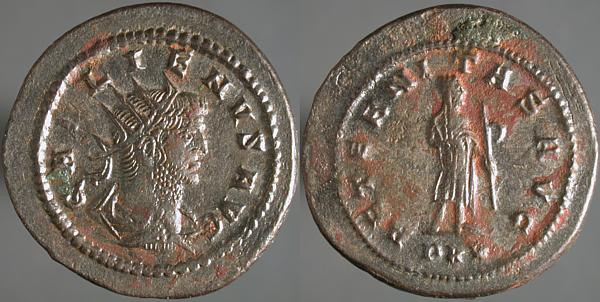
GALLIENVS AVG, Radiate draped cuirassed bust right | AETERNITAS AVG, Saturn standing facing, head right, holding harpa right. PXV in exergue.
Saturn doesn't make many appearances on Roman coins, though Antioch in both the joint reign of Valerian and Gallienus, and later during the sole reign of Gallienus, did produce a few. Saturn is equated with the Greek Kronos, who used a sickle (or this long-handled harpa) in his role as harvest god, and to castrate his father Uranus.
With its PXV mark, this is from the same time as Monday's coin.
Wednesday, December 08, 2004
AR denarius, Rome, Septimius Severus, 204 CE, RIC 266D
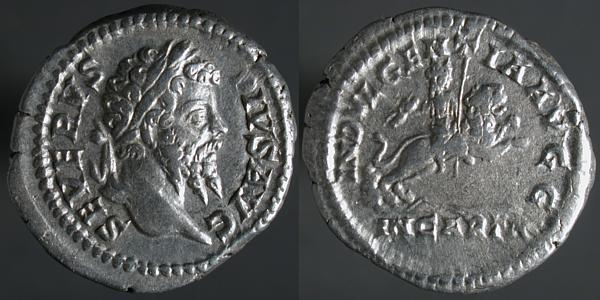
SEVERVS PIVS AVG, Laureate head right | INDVLGENTIA AVG, Dea Caelestis riding right on lion over water gushing from rock to the left, holding thunderbolt and scepter. IN CARTH in exergue.
After the assassination of Commodus on the last day of 192, Publius Helvius Pertinax became emperor. His coins are rare and expensive, and I have none, but some belonging to others are pictured here. Pertinax was assassinated by his Praetorian Guard in late March of that year.
The Praetorians then apparently auctioned the office, won by Marcus Didius Severus Julianus who proved unable to pay the 25,000 sesterces per soldier he'd bid, and his assassination took place after he'd reigned for 66 days. Again, I have none of his coins to show. Some are pictured here.
Meanwhile, the governor of Syria, Gaius Pescennius Niger, proclaimed himself emperor, and marched his army towards Rome. In a refrain familiar in this post, I have none of his rare coins, but some are here.
He died fighting in early 194.
One of his opponents was governor of Britain Decimus Clodius Albinus, who, after various intrigues, accepted the lesser title of Caesar. A coin of his, with that title, is shown here. His title was withdrawn in 196, followed by his revolt, defeat, and death in February 197.
The winner in the tumult of 193 was Lucius Septimius Severus, the first emperor born outside of Italy. He had good military success during his reign even if life at home was fractious.
He died, of natural causes, in February 211, leaving his sons Caracalla and Geta to contend for power. It didn't work out of, of which more in two weeks.
There's an interesting page on this series of coins, commemorating work on an aqueduct at Carthage, here.
Tuesday, December 07, 2004
Æ29, Tyre in Phoenicia, Gallienus, Lindgren I, 2399
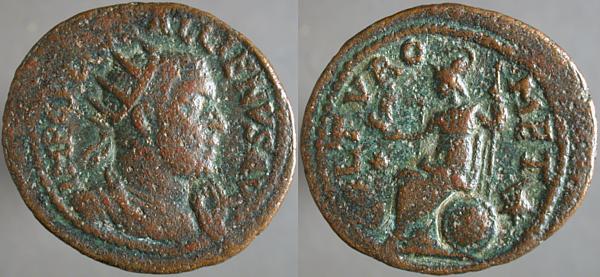
IMP C P LIC GALLIENVS AVG, Radiate cuirassed bust right | COL TVRO MET, Roma seated left, holding Nike left and scepter right. Star in left field, murex shell in extreme right field.
Sur, Lebanon, is on the site of ancient Tyre, on the Mediterranean. There are still some ruins from antiquity there.
The murex shell is a common feature on their coins, as a symbol of the locally-produced Tyrian purple, a famous and expensive dye, especially popular with the Romans.
Everybody who was anybody had something dyed purple.
Monday, December 06, 2004
Silvered Æ antoninianus, Gallienus, Antioch, Göbl 1668i
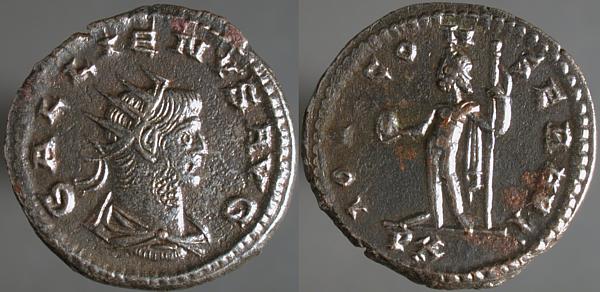
GALLIENVS AVG, Radiate draped cuirassed bust right | IOVI CONSERVAT, Jove standing facing, head left, holding long scepter right and globe left. PXV in exergue.
Unlike that on Saturday's coin, this message, "to Jove the preserver," seems to correspond to our expectations of pagan Rome.
PXV in the exergue is understood to indicate that Gallienus has Tribunucian power for the 15th time, dating this to between September 266 and a year later.
Sunday, December 05, 2004
Æ26, Damascus in Coele-Syria, Salonina, Sear GIC 4691
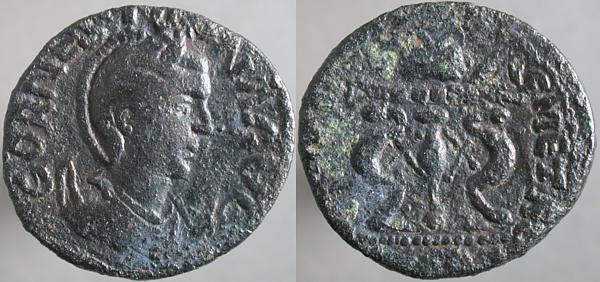
CORNE SA[...]NA AVG, Diademed draped bust right on crescent | [COL ?AMA]_S METRO, Palm branch and prize crown with palm branches protruding on table.
Another coin that seems to show a prize for the winner of a competition, this time minted in the name of Salonina (looking rather mannish here), wife of Gallienus, at the city of Damascus.

